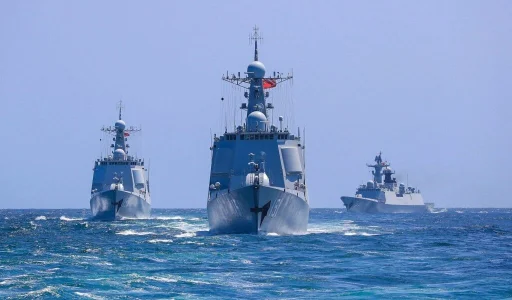The tensions between China and Taiwan have deep historical roots, but recent military escalations highlight the growing strain in their relationship. China views Taiwan as a breakaway province that must eventually be reunified with the mainland, by force if necessary, despite Taiwan’s functioning as a self-governed democracy since the end of the Chinese civil war in 1949.
Over the decades, this fundamental disagreement has led to periodic flare-ups, with China increasing both political pressure and military activity around Taiwan.
Beijing’s military exercises, such as the recent drills involving fighter jets, drones, warships, and Coast Guard vessels, are part of its strategy to intimidate Taiwan and signal to both Taipei and the international community its determination to assert control over the island.
By simulating blockades and large-scale military operations, China aims to demonstrate its military capability to isolate and potentially invade Taiwan if the need arises.
From Taiwan’s perspective, these actions are viewed as provocations and attempts to destabilize the region, threatening its sovereignty and security. Taipei has condemned such maneuvers as reckless and unjustified, accusing China of trying to bully it into submission. The island, backed diplomatically and militarily by the U.S. and other allies, continues to resist any notion of reunification on China’s terms.
China’s frequent military drills around Taiwan also reflect its displeasure with increased international support for Taiwan, especially from the United States, which has ramped up arms sales and official exchanges with Taipei. Beijing sees these developments as a violation of its “One China” policy, further fueling tensions and prompting more aggressive actions.
The current military activities are not isolated incidents but part of a broader Chinese strategy to assert dominance over the Taiwan Strait and gradually weaken Taiwan’s resolve.
These military demonstrations are intended to both prepare for potential conflict and discourage Taiwan from moving toward formal independence, while also sending a message to the global community about China’s growing influence in the region.
China’s intentions toward Taiwan stem from its long-standing goal of reunification, which it sees as essential to its national sovereignty and territorial integrity.
Beijing’s leadership, under President Xi Jinping, has emphasized that resolving the “Taiwan issue” is a matter of completing China’s rejuvenation as a global power. China’s increased military activities around Taiwan reflect a combination of assertiveness and strategic calculation, signaling its willingness to use force if necessary, but also testing international reactions, especially from the West.
China views the U.S. and its allies with suspicion, interpreting any support for Taiwan as interference in its internal affairs. From Beijing’s perspective, the U.S. presence in the region, including arms sales and diplomatic gestures toward Taiwan, is a direct challenge to China’s sovereignty. However, the more China perceives hesitation or internal political division in the West, the more it might feel emboldened to escalate tensions.
China’s aggressive posture could also be interpreted as testing the limits of Western resolve, particularly as the U.S. and its allies are perceived by Beijing to be preoccupied with other global issues, such as the war in Ukraine or economic challenges.
The U.S. faces a complex dilemma in preventing Chinese provocations.
On one hand, it must show firm support for Taiwan to deter Chinese aggression and maintain stability in the Indo-Pacific region. This can involve continuing arms sales, conducting military exercises in the area, and strengthening alliances with other regional powers like Japan, South Korea, and Australia.
On the other hand, the U.S. has to balance its actions to avoid pushing China into a corner, which could escalate the situation into open conflict.
The U.S.-China relationship is deeply affected by these tensions. As China intensifies its military activities, Washington is compelled to respond, which can result in a cycle of actions and reactions that heightens the risk of miscalculation.
Economic and diplomatic relations are also strained as the U.S. seeks to curtail China’s technological advancements and influence while maintaining critical trade ties. This tension creates an unstable foundation for their broader relationship, where both cooperation and competition coexist in an uneasy balance.
The challenge for the U.S. lies in navigating this high-stakes environment, where its actions must be decisive enough to reassure Taiwan and regional allies, yet measured to avoid outright confrontation with China.
Diplomatically, the U.S. can work to build international consensus, reinforcing the principle that any resolution to the Taiwan issue must be peaceful.
However, the more China perceives itself as a rising power in a world where the West is distracted or divided, the more it may feel justified in exercising its influence, making the prospect of a long-term peaceful resolution increasingly uncertain.
